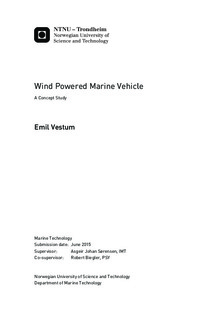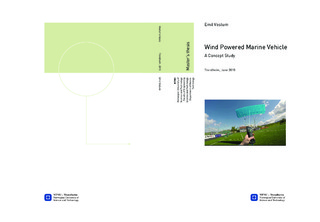| dc.description.abstract | In conventional sailboat design, the heeling momentum introduced by the
rigid connection of foils in air and water is a limitation on the maximum ve-
locity. By removing the hull all together, wetted surface induced drag can be
removed and increase the theoretical maximum velocity of a sailboat. Today
ROV s are limited by their attachment to a parent ship through the umbil-
ical. AUV s have operational limits due to energy storage capacity. Wind
is a readably available energy source and is exploited in traditional sailing.
By exploiting the wind energy a marine vehicle can increase the operational
space compared to conventional vehicles. This can be done by incorporat-
ing foils for sailing and an energy harvesting system to increase no wind
performance. The high vantage point of kites can improve communication
and energy harvesting capabilities. Efficient aerofoils have unstable flight
dynamics and high frequency response, and introduce several challenges for
a control system. By neglecting higher order dynamics, a simplified model
in combination with experimental data can be used to investigate different
approaches in control system design regarding a wind powered marine vehi-
cle application where a kite is utilized for propulsion. A paravane can reflect
the kite forces in the water with minimum drag and opts for a high speed
sailing vehicle that can expand or combine the existing workspace covered
by ROV s and AUV s today.
A PID-controller will not be able to control a kite when a random walk pro-
cess is introduced on the ambient wind. Different optimization approaches,
such as MPC using NLP algorithms and thrust allocation theory, should
be considered in future work regarding design of a control system for kites.
However, the solution in a thrust allocation approach may not always exist,
and specially at critical points in the system response. A feedback lineariza-
tion approach may not be trivial to apply, as the control inputs are coupled
for a parawing kite. Errors accumulate quickly, and when approximations
are involved, control on the error dynamics based on the residual from the
linearization may be insufficient. | |

